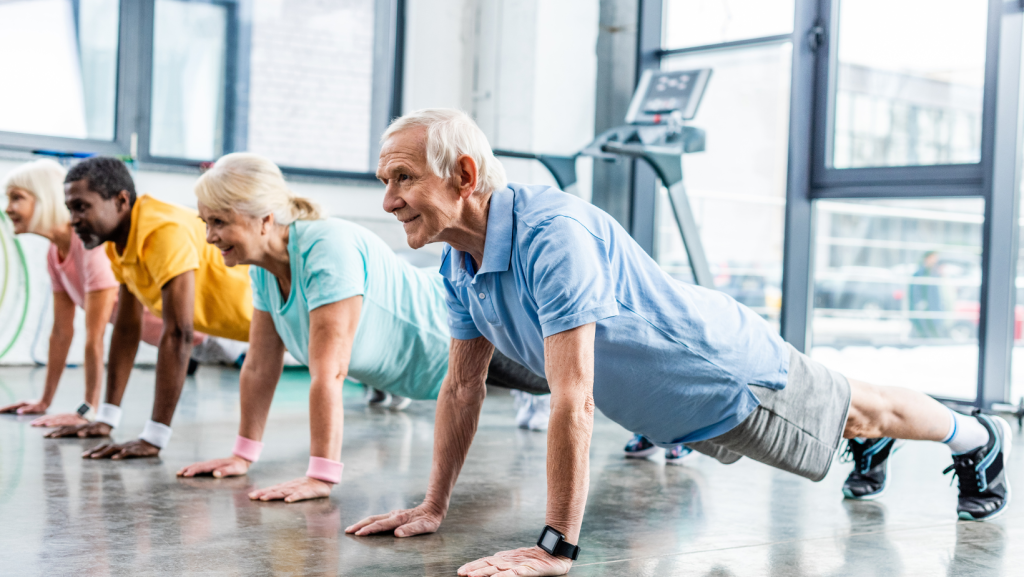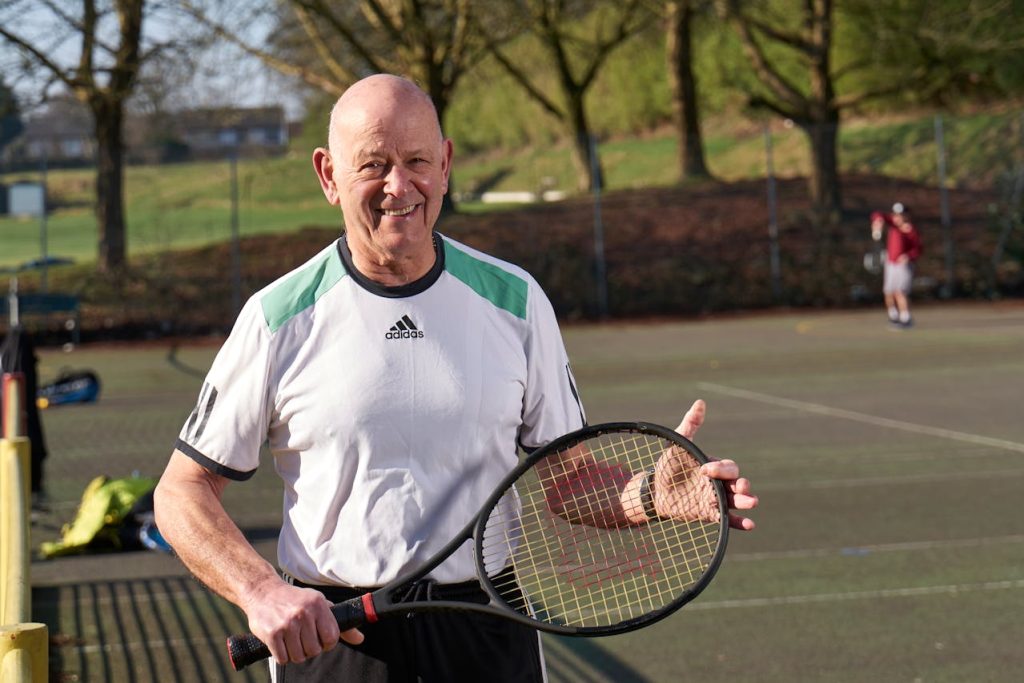Corrective exercise for seniors is a crucial component of healthy aging. Understanding what it entails and why it is essential can significantly impact the overall well-being of older adults. These exercises focus on improving mobility, stability, and posture, helping seniors maintain independence and quality of life as they age. Corrective exercises play a vital role in preventing injuries and promoting longevity by addressing movement imbalances and enhancing functional abilities. Corrective exercise is important for older adults as it helps with healthy aging. This type of exercise offers many benefits and plays a key role in promoting overall well-being for seniors.

Understanding Corrective Exercise
Corrective exercise is a specialized approach focusing on improving movement patterns and addressing musculoskeletal imbalances in seniors. It plays a crucial role in enhancing overall physical function, reducing pain, and preventing injuries. Certain correction exercises, like posture correction exercises and targeted exercises, benefit seniors by promoting better alignment and mobility. A structured corrective exercise program with tailored routines and motion exercises supports seniors on their journey to better health.
Definition and Purpose
Corrective exercise targets specific movement deficiencies in seniors for improved physical function.
Corrective exercise is like a special kind of exercise that helps older people move better and feel stronger. It’s kind of like having a secret weapon to help your body work the way it’s supposed to. You see, as we get older, our bodies may not move as easily as they used to. Sometimes our muscles get tight or weak, or our joints don’t bend like they should. That’s where corrective exercise comes in! It’s like a personalized workout plan that focuses on fixing these little problems so that seniors can stay active and independent for longer.
When seniors do corrective exercises, they are targeting specific areas in their bodies that need a little extra help. For example, if someone has trouble bending down to tie their shoes because their hips are tight, a corrective exercise program might include stretches and movements to loosen up those hip muscles. By doing these exercises regularly, seniors can improve their flexibility and mobility, making everyday tasks easier and more comfortable.
One cool thing about corrective exercise is that it’s not just about fixing problems – it’s also about preventing them from happening in the first place. By addressing small issues early on, seniors can reduce their risk of falls, injuries, and other health problems down the road. It’s like giving your body a tune-up to keep it running smoothly for years to come!
Understanding individual health goals is crucial for creating personalized exercise plans.
Understanding individual health goals is important because everyone is different and has unique needs. When we talk about health goals, we mean what each person wants to achieve with their exercise routine. For seniors, this could be things like improving balance, reducing joint pain, or increasing flexibility. By knowing these goals, fitness trainers and physical therapists can create personalized exercise plans that target specific areas that need improvement. This means that seniors can get the most out of their workouts and see better results in terms of their overall health and well-being. So, it’s like having a roadmap that guides you toward your destination – in this case, better health!
The assessment ensures tailored routines that meet seniors’ unique needs and abilities.
Assessing seniors is important for trainers to know what each one needs. They can figure out what exercises will work best for them based on their abilities and any health issues they might have. This way, the seniors can do exercises that are safe and effective for them. It’s like getting a personalized workout plan made just for them! So, when they do their corrective exercises, they know they’re doing the right ones to help them stay healthy and strong as they get older.
Incorporating corrective exercise leads to enhanced mobility, reduced pain, and improved quality of life.
When seniors do corrective exercises, they can bend, stretch, and walk more easily. This means they can stay independent and do things they enjoy without feeling uncomfortable or achy. Imagine your grandparents being able to play with you in the park without getting tired quickly or feeling sore afterward! That’s the magic of corrective exercise – it keeps them feeling young and active. So, next time you see your grandma or grandpa doing their special exercises, remember that it’s helping them stay healthy and happy!
Addressing Common Senior Issues
As we get older, our bodies go through some changes that can make it harder to move around and do the things we love. Seniors often find themselves struggling with balance issues, achy joints, and not being as flexible as they used to be. But don’t worry, there’s a way to help with all of that – it’s called corrective exercise! This type of exercise focuses on doing specific movements that target key muscles in our bodies, making them stronger and more flexible. By doing these exercises regularly, seniors can prevent injuries and stay healthier in the long run.
When we do corrective exercises, we’re not just working out for the sake of it – we’re helping our bodies function better every day. For example, if someone has trouble with their balance, some exercises can help improve coordination and stability. And if joints are feeling stiff and painful, certain movements can help ease that discomfort and improve mobility. It’s like giving our bodies a tune-up to keep everything running smoothly!
But here’s the best part – doing these exercises doesn’t have to be a solo mission. Involving family members or friends in your workout routine can make it more fun and motivating. You can cheer each other on, set goals together, and celebrate achievements as a team. Plus, it’s a great way to spend quality time with loved ones while also taking care of your health.
Importance for Healthy Aging
Engaging in regular exercises that are specially designed for seniors can help improve how well you can move and how strong you are. Corrective exercise is all about fixing any imbalances in your body to stop injuries that might make it hard to do things you need to do every day. By setting realistic health goals and using good plans to stay fit, you can make sure you’re on the right track. It’s also nice to include your family and friends in your exercise routines because it helps you stay connected with others and share fun fitness moments. So, remember, doing these exercises can help you feel better and stronger as you get older!
Benefits of Corrective Exercises
Improving posture and alignment is crucial in corrective exercise programs for seniors, as it enhances body mechanics. Incorporating targeted posture correction exercises can help seniors maintain proper posture, reducing strain on muscles and joints.
Enhancing balance and stability through specific balance exercises is essential for seniors to prevent falls. These exercises focus on improving coordination and proprioception, ultimately promoting safer mobility and independence.
Increasing flexibility and range of motion with motion exercises is beneficial for seniors’ daily activities. By incorporating these exercises into a corrective exercise regimen, seniors can experience improved joint mobility and overall quality of life.
Supporting injury prevention and rehabilitation is a key aspect of corrective exercise training for seniors. This training allows seniors to recover effectively from injuries, enabling them to maintain an active lifestyle and prevent future injuries.
Improve Balance and Strength
- Addressing specific muscle imbalances through targeted exercises helps enhance muscle balance, promoting overall stability and coordination in seniors.
- Including balance exercises and core stabilization exercises in routine workouts can significantly improve strength and reduce the risk of falls, crucial for maintaining seniors’ safety.
- Implementing various neuromuscular exercises as part of exercise rehabilitation can strengthen key muscle groups, enhancing functional movement and balance in seniors.
- Following exercise guidance that includes certain correction exercises ensures a comprehensive approach to improving balance and strength in seniors.
Manage Joint Pain
- Tailoring effective exercise interventions based on assessments by knowledgeable chiropractors helps identify the source of pain in seniors, leading to personalized treatment plans.
- Incorporating motion exercises and balance exercises into daily routines can enhance mobility, reduce back pain, and promote joint health among seniors.
- Utilizing chiropractic care such as adjustments and modern treatments supports injury recovery, alleviates joint pain, and facilitates healing for seniors.
- Seeking expert chiropractors’ advice for personalized exercise therapy plans can effectively address specific joint pain issues and improve overall joint health in seniors.
Enhance Overall Wellness
- Integrating corrective exercise into daily routines promotes physical health and mental well-being in seniors, contributing to overall wellness.
- Tailored exercise programs focusing on strengthening and improving fitness levels support health goals, leading to enhanced overall health outcomes for seniors.
- Regular participation in exercises as part of an effective strategy aids in healing, rehabilitation, and injury prevention among seniors.
- Structured exercise interventions that enhance mobility and flexibility contribute to a more active and fulfilling lifestyle for seniors, fostering long-term well-being.
Customized Exercise Programs
Develop personalized exercises tailored to individual needs, ensuring seniors receive targeted exercise programs. Incorporate exercises to enhance strength, flexibility, and balance for healthy aging. Design corrective regimens with specific exercises for postural imbalances and injury prevention.
Provide exercise guidance through training sessions to educate seniors on effective strategies and safe motion exercises. Collaborate with professionals for integrated rehabilitation therapies to maximize benefits in fitness routines.
Tailored to Individual Needs
- Assess unique requirements and goals to create personalized exercises.
- Design targeted exercises focusing on flexibility and overall wellness.
- Implement adjustments based on ongoing evaluations for program effectiveness.
- Integrate various rehabilitation therapies with tailored fitness routines.
Assessment and Evaluation
- Conduct thorough assessments to identify mobility limitations.
- Utilize evaluations to track progress and measure rehabilitation effectiveness.
- Guide tailored exercises promoting health and recovery.
- Encourage family activity participation in supportive environments.
Emotional and Psychological Gains
- Engage in corrective exercises for emotional well-being and reduced anxiety.
- Achieve health goals for improved self-esteem and confidence.
- Participate in group exercise sessions for social interaction and community connection.
- Support recovery processes for lasting physical and emotional benefits.
Injury Prevention and Recovery
Understanding Muscle Imbalances
Identifying muscle imbalances is crucial to comprehend how weak muscles impact body mechanics and posture. Recognizing the significance of muscle balance helps in maintaining proper alignment, reducing the risk of injuries. Incorporating neuromuscular and balance exercises addresses imbalances and boosts body awareness. Corrective exercise routines involving specific correction and motion exercises enhance strength and stability in seniors.
Prevent Further Injuries
- Implement corrective exercises to enhance proper alignment, minimizing injury risks during daily activities.
- Utilize exercise rehabilitation techniques to expedite injury recovery, aiding faster healing and mobility restoration.
- Regularly engage in exercises focusing on strength and flexibility to significantly reduce future injury probabilities.
- Seek guidance from professionals like chiropractors for effective treatment and tailored interventions for seniors.
Speed Up Recovery Process
Accelerate recovery by incorporating targeted corrective exercises that boost the healing process post-injuries. Facilitate injury recovery through structured rehabilitation programs tailored to individual needs. Monitor progress closely to ensure substantial improvements in the recovery journey, adjusting the regimen as needed. Leverage various rehabilitation therapies alongside exercise therapy for a comprehensive recovery approach.
Integrating Exercises into Daily Life
When incorporating regular exercises into daily life, it’s crucial to schedule specific times for workouts. This ensures consistency and commitment to an exercise program that promotes healthy aging. Exploring different exercises that target various muscle groups is essential. Include balance exercises and motion exercises to enhance overall strength and stability.
Seeking exercise guidance from professionals is key to developing personalized exercises tailored to individual needs and limitations. This maximizes the effectiveness of the exercise regimen. Implementing effective exercise strategies involves combining many exercises into a general routine. This routine should include targeted exercises for rehabilitation and overall health improvement.
Strategies for Consistency
- Establish a regular exercise routine by scheduling specific times for workouts each week.
- Focus on proper alignment and stability in exercises for safety and effectiveness.
- Gradually integrate strengthening and flexibility exercises into daily life.
- Seek guidance from professionals or structured programs for motivation and engagement.
Leverage Technology and Apps
- Explore apps designed for seniors focusing on corrective exercise.
- Utilize fitness programs with technology to track progress and improvements.
- Access websites offering tailored exercise programs for a personalized approach.
- Integrate tech into routines for increased motivation and monitoring effectiveness.
Incorporate into Daily Tasks
- Integrate specific exercises into daily routines to make physical activity natural.
- Develop strategies that can be performed during regular tasks, like stretching while waiting.
- Encourage family activities involving various exercises for fitness and social interaction.
- Establish habits by incorporating short exercise programs into existing routines.
Role of Progress Tracking
Progress tracking plays a vital role in a corrective exercise journey for seniors, allowing them to measure improvements and align with their health goals effectively. By utilizing assessments, individuals can identify specific areas that require attention, enabling tailored strategies for a more efficient recovery process. Regularly tracking outcomes is crucial as it helps evaluate the effectiveness of corrective exercises, facilitating necessary adjustments to enhance overall performance. Setting realistic tasks and milestones guides the recovery journey, promoting motivation and accountability among seniors.
Importance of Monitoring Progress
- Significance of progress tracking: Ensures seniors remain motivated and committed to their fitness routines.
- Regular assessments help evaluate improvements and identify areas needing more focus or adjustment.
- Utilize tracking methods to measure outcomes and ensure health goals are met and maintained over time.
- Consistency in performing focused movements and exercises leads to significant improvements in overall health.
Tools for Tracking Success
- Implement progress-tracking methods to monitor improvements in strength, flexibility, and overall fitness levels.
- Utilize assessments to evaluate the effectiveness of targeted exercises and adjust programs accordingly.
- Set clear health goals and regularly track outcomes to ensure alignment with desired results.
- Explore various strategies like fitness apps or journals for tracking workouts to maintain motivation.
Adjusting Programs Based on Data
- Use data from progress tracking to make informed adjustments to exercise programs tailored for seniors.
- Incorporate chiropractic adjustments into corrective exercise programs to enhance flexibility and reduce discomfort.
- Leverage fitness apps for real-time guidance on effective stretching and corrective exercises.
- Develop individualized treatment plans focusing on improvements in strength, balance, and mobility through consistent program adjustments.
Final Remarks
Understanding corrective exercises’ importance for seniors’ health and well-being, customizing exercise programs to individual needs, and focusing on injury prevention and recovery are vital components of a holistic approach to healthy aging. Integrating these exercises into daily life and diligently tracking progress can significantly enhance seniors’ quality of life by improving mobility, strength, and overall functionality. Embracing corrective exercises not only fosters physical well-being but also contributes to mental health and independence as individuals age.
For optimal results, incorporating these practices consistently and seeking professional guidance when needed are crucial steps in reaping the full benefits of corrective exercises for seniors. By prioritizing proactive measures such as tailored exercise regimens and injury prevention strategies, seniors can enjoy a more active, fulfilling lifestyle well into their golden years.

Frequently Asked Questions
What is Corrective Exercise?
Corrective exercise focuses on identifying and addressing movement dysfunctions to improve overall functionality. It involves specific exercises tailored to an individual’s needs to correct imbalances, prevent injuries, and enhance performance.
Why are Corrective Exercises Essential for Seniors?
Corrective exercises for seniors help maintain mobility, improve balance, and prevent falls. They address age-related issues like muscle weakness, joint stiffness, and posture problems, promoting healthy aging and independent living.
How are Customized Exercise Programs Beneficial?
Customized exercise programs consider an individual’s unique needs, limitations, and goals. By tailoring exercises specifically to address these factors, they optimize effectiveness, reduce injury risk, and ensure long-term adherence and progress.
What Role Does Progress Tracking Play in Corrective Exercise?
Tracking progress in corrective exercises allows individuals to monitor improvements, identify areas needing adjustment, and stay motivated. It provides valuable feedback on the effectiveness of the program and helps adjust strategies for better outcomes.
How Can Corrective Exercises be Integrated into Daily Life?
Integrating corrective exercises into daily routines ensures consistency and long-term benefits. Simple strategies like incorporating stretches during breaks, using household items as workout props, or setting reminders can help make exercise a seamless part of everyday life.
Enhance Your Retirement Wellness with Personalized Coaching at Fitness Ellipsis!
Are you ready to embrace a more fulfilling and balanced lifestyle in retirement? At Fitness Ellipsis, we understand that true well-being in your golden years goes beyond just physical fitness—it’s about nurturing your mental, emotional, and physical health through holistic wellness practices. Our team of experienced coaches is dedicated to providing personalized wellness assessments designed to support your unique retirement goals.
Whether you’re new to the concept of wellness coaching or looking to elevate your current routine, we offer comprehensive, age-appropriate wellness programs to help you flourish in every aspect of your life. From individualized coaching plans to expert advice on mindfulness, nutrition, and physical well-being, we ensure that you stay energized, healthy, and purposeful throughout your retirement years.Don’t just wish for a more balanced retirement—make it happen! Join the Fitness Ellipsis community and embark on your journey toward a healthier, more vibrant, and fulfilling future. Connect with us today to discover how our personalized coaching services can transform your retirement. Your path to optimal well-being starts here!




